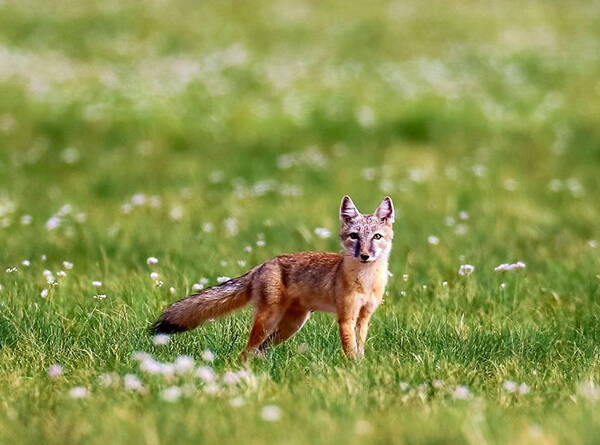Vulpes velox
IUCN
LCBasic Information
Scientific classification
- name:Vulpes velox
- Scientific Name:Vulpes velox,Swift Fox
- Outline:Carnivora
- Family:Schizopoda Canidae Vulpes
Vital signs
- length:About 80 cm
- Weight:2-3kg
- lifetime:3-14 years
Feature
The savannah fox is the smallest wild canid in North America.
Distribution and Habitat
The steppe fox is native to the plains of western Canada and the Great Plains of North America to Texas. The fox quickly disappeared completely from Canada in the 1930s, but has been reintroduced there. There are some scattered populations in the Great Plains of the United States and western Canada. The largest populations are in Colorado, Kansas, New Mexico, and Wyoming, where the species is stable. Only about 350 individuals live in southeastern Alberta and southwestern Saskatchewan, Canada.
Inhabits temperate terrestrial biomes, primarily in grasslands, dunes, and deserts. Often found in open grasslands, fenced or plowed fields in the sand.
Appearance
An adult steppe fox weighs 2-3 kg, is about 30 cm tall at the shoulder, and is about 80 cm long, roughly the same size as a domestic cat. It is a small fox, smaller than the red fox. In North America, the steppe fox is the smallest wild canid. It has large, pointed ears. Its fur is light gray, with orange-yellow sides and legs, and creamy white throat, chest, undersides and insides of the ears. Its tail is black, with dense fur and black fur at the tip. There are black spots on both sides of its nose. Male and female foxes are similar in size, but slightly larger. The fur begins to thicken as summer draws to a close.
Details
The veld fox (scientific name: Vulpes velox) is also known as the Swift Fox in English. It has three subspecies.

Steppe foxes are agile and can run up to 50 kilometers per hour. Their swift running helps them catch food and avoid being hunted by other predators. Hiding in underground caves is another way for them to avoid predators. These underground caves are generally 2-4 meters long and have 4 entrances. The steppe fox is mainly active at night, hiding in caves during the day, but this varies with the seasons. In winter, they will come out of their caves to bask in the sun on warm afternoons; in summer, they only appear on the ground in the evening and at night. The food they catch varies with the season, including small mammals, birds, reptiles, amphibians, fish, insects, as well as berries and weeds.
It only takes one year for male foxes to mature and mate, while female foxes have to wait until the second year after giving birth. The breeding season in Canada begins in March, and female foxes give birth to cubs in mid-May after a gestation period of 50-60 days. Further south in the United States, the breeding season is advanced to late December to early January, and cubs are born in March or early April. Female foxes breed once a year and give birth to 2-6 cubs. Newborn cubs stay in underground caves for 1 month. About 10-15 days after birth, the eyes and ears of the young foxes are not yet fully developed and cannot perceive the surrounding environment. They need to be fed and cared for by the mother fox. The young foxes are weaned at 6-7 weeks and still live with their parents until autumn. The life span of wild steppe foxes is about 3-6 years, and domestic foxes can live for 14 years.
In Canada, steppe foxes mainly live on unprotected land, but about one-sixth of the species belong to the boundaries of grasslands and national parks. There are 24 national park distribution areas (parks, monuments, historical sites) in the United States, which are the traditional living range of steppe foxes. However, in the 2009 survey, except for the Badlands Regional National Park in South Dakota, there were no records of steppe foxes in other areas. Other areas of federal jurisdiction in the United States where steppe foxes have been found include national grasslands, Bureau of Land Management lands, the Pinon Canyon Manoever site, the Rocky Mountain Arsenal, and wildlife refuges, which are not national parks but provide protection from hunting.
In Canada, the National Steppe Fox Recovery Team revised the National Recovery Strategy in 2008 (Pruss et al. 2008), implemented through provincial action plans. Subsequent addenda recommended that these areas should be considered critical habitat and protected as such. The long-term goal is to restore a self-sustaining steppe fox population of more than 1,000 breeding foxes by 2026, with no more than a 30% decline in numbers in any 10-year period.
Listed on the 2016 IUCN Red List of Threatened Species, ver 3.1 - Least Concern (LC).
Protect wild animals and stop eating game.
Maintaining ecological balance is everyone's responsibility!








